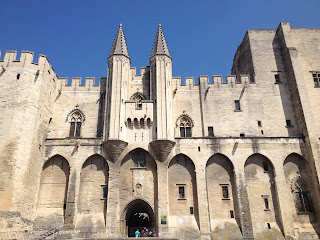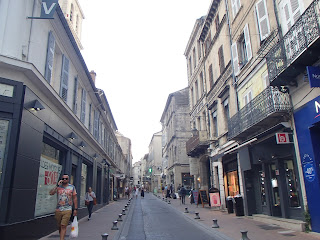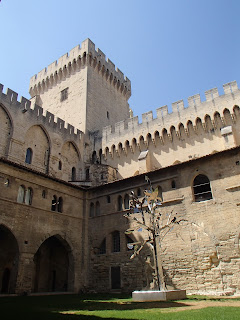The ancient city of Avignon is best known
for being the seat of papacy for more than a century. It was first Pope Clement V, who was originally from
Bordeaux, that moved the Roman Catholic papacy to Avignon in 1300s. During the
papacy resign, the papal palace was built and further extended into the largest
gothic palace in Europe. Avignon then remained as a
papal territory until the French Revolution.
Most of the attractions lie within the historic centre of the medieval city which is surrounded by ancient rampart.
 |
| Map of the historic centre of Avignon |
What to see:
1. Papal palace or Palais des Papes - symbolic attraction in Avignon and the largest gothic palace in Europe.
 |
| Entrance of the palace |
 |
| tranquil courtyard |
 |
| Essential to get an audio guide! |
 |
| View of the Pope's (used-to-be) garden |
 |
| Imagine they used to store all the valuables here |
 |
| The main square is being used for concerts still |
2.
Notre
Dame des Doms – Romanesque cathedral and its most prominent feature is the 19th century gilded
statue of the Virgin which surmounts the western tower.
 |
| Notre Dame des Doms next to the pope's palace |
3. Ramparts
surrounding old town – built in the 14th century during medieval
times and still holding strong now.
 |
| alongside the rampart |
4. Avignon
bridge or Pont d’Avignon - bridge that
tells the sad story of Saint Benezet and featured in the French song Sur le
pont d’Avignon. Today only 4 out of the original 21 piers are left so you can
only see half a bridge.
 |
| Part of the bridge still standing |
 |
| View of the Rhone river |
5. Explore the historic centre
 |
| Main shopping district |
 |
| the city hall |
 |
| Threatre building |
6. Visit the Pont du Gard
As a side trip
from Avignon, it is possible to drive to Pont du Gard – the largest roman
aqueduct ever built. There are 2 side you can enter from and I would recommend
parking at the left bank. It is on a lower ground and you can walk on the river bank
below the aqueduct for a close up view.
 |
| First glimpse from the river |
 |
| Play time in clear water |
 |
| crossing the bridge |
 |
| View from the bridge |
Cross the bridge
over to the side and there is a small hike up a slope for a lookout point where
you can get a panoramic view.
 |
| Possible to climb to the top of the bridge but only with group reservation |
Return back
across the bridge and visit the museum that explains the history and
architectural background of the aqueduct before you leave.
Where to stay:
Domaine de Rhodes is an estate located on the little Barthelasse
island (L'île de la Barthelasse) across Avignon old town. The island nestles
between the 2 branches of the Rhone river. The house used to be a 16th
century hunting lodge and used to be owned by some rich nobility but later on
bought over by the family now running it as a B&B. It is the largest
B&B in terms of ground size we’ve seen. They have several side cottages and
apartments for rental, a large swimming pool with sundecks, and their own park
in the estate.
The
entire house is tastefully decorated in old French style. Room was comfortable
with a modern shower in the toilet.
 |
| Facade of the main house |
 |
| A small part of the park |
 |
| Living room chill out area |
 |
| Dining area for breakfast (wet weather) |
 |
| Our double room |
 |
| Toilet is modern style |
Where to eat:
1. Le bistro du Moulin @ Villeneuve les Avignon
On our first night in Avignon our B&B Host recommended le bistrot du Moulin to us. Villeneuve-lès-Avignon is a town across the
Rhone river from Avignon old town, with Barthelasse island in between.
Dessert seems to be a highlight everywhere.
In le bistrot du Moulin they are displayed on a big round table and a waitress will be around
to assist as the patrons browse the wide selection.
 |
| Main street in Villeneuve les Avignon |
 |
| Courtyard outdoor dining option is available |
 |
| We chose to sit inside the old mill. |






















































No comments :
Post a Comment